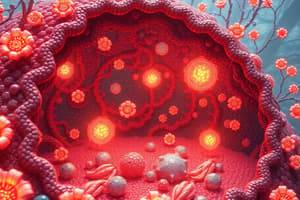Podcast
Questions and Answers
Which process transports molecules through the cell membrane against the concentration gradient?
Which process transports molecules through the cell membrane against the concentration gradient?
- Diffusion
- Facilitated diffusion
- Active transport (correct)
- Osmosis
Which process disrupts the equilibrium established by diffusion?
Which process disrupts the equilibrium established by diffusion?
- Endocytosis
- Osmosis
- Active transport (correct)
- Facilitated diffusion
What does active transport help maintain between cells and extracellular fluid?
What does active transport help maintain between cells and extracellular fluid?
- Dynamic equilibrium (correct)
- Diffusion
- Equilibrium
- Osmosis
What happens to diffusion/osmosis after equilibrium is established?
What happens to diffusion/osmosis after equilibrium is established?
What type of molecules can enter/exit through active transport?
What type of molecules can enter/exit through active transport?
What is the main requirement for active transport to occur?
What is the main requirement for active transport to occur?
What does active transport do to the concentration of a substance inside the cell?
What does active transport do to the concentration of a substance inside the cell?
What does active transport do to the concentration of a substance outside the cell?
What does active transport do to the concentration of a substance outside the cell?
Which process requires cellular energy to move molecules from a low concentration to a high concentration?
Which process requires cellular energy to move molecules from a low concentration to a high concentration?
Which type of transport does not require cellular energy?
Which type of transport does not require cellular energy?
Which type of transport moves substances from high concentration to low concentration?
Which type of transport moves substances from high concentration to low concentration?
Which types of particles are transported through active transport?
Which types of particles are transported through active transport?
Which types of particles are transported through passive transport?
Which types of particles are transported through passive transport?
Which process maintains equilibrium in the cell?
Which process maintains equilibrium in the cell?
Which types of transport are examples of passive transport?
Which types of transport are examples of passive transport?
Why do amino acids, sugars, and lipids need to enter the cell through active transport?
Why do amino acids, sugars, and lipids need to enter the cell through active transport?



